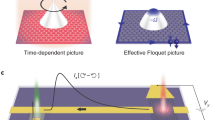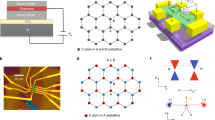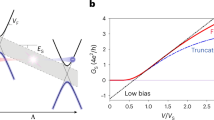Abstract
When the Fermi level is aligned with the Dirac point of graphene, reduced charge screening greatly enhances electron–electron scattering1,2,3,4,5. In an optically excited system, the kinematics of electron–electron scattering in Dirac fermions is predicted to give rise to novel optoelectronic phenomena6,7,8,9,10,11. In this paper, we report on the observation of an intrinsic photocurrent in graphene, which occurs in a different parameter regime from all the previously observed photothermoelectric or photovoltaic photocurrents in graphene12,13,14,15,16,17,18,19,20: the photocurrent emerges exclusively at the charge neutrality point, requiring no finite doping. Unlike other photocurrent types that are enhanced near p–n or contact junctions, the photocurrent observed in our work arises near the edges/corners. By systematic data analyses, we show that the phenomenon stems from the unique electron–electron scattering kinematics in charge-neutral graphene. Our results not only highlight the intriguing electron dynamics in the optoelectronic response of Dirac fermions, but also offer a new scheme for photodetection and energy harvesting applications based on intrinsic, charge-neutral Dirac fermions.
This is a preview of subscription content, access via your institution
Access options
Access Nature and 54 other Nature Portfolio journals
Get Nature+, our best-value online-access subscription
$29.99 / 30 days
cancel any time
Subscribe to this journal
Receive 12 print issues and online access
$259.00 per year
only $21.58 per issue
Buy this article
- Purchase on Springer Link
- Instant access to full article PDF
Prices may be subject to local taxes which are calculated during checkout




Similar content being viewed by others
References
Neto, A. C., Guinea, F., Peres, N., Novoselov, K. S. & Geim, A. K. The electronic properties of graphene. Rev. Mod. Phys. 81, 109–162 (2009).
Sarma, S. D., Adam, S., Hwang, E. & Rossi, E. Electronic transport in two-dimensional graphene. Rev. Mod. Phys. 83, 407–470 (2011).
Kotov, V. N., Uchoa, B., Pereira, V. M., Guinea, F. & Neto, A. C. Electron–electron interactions in graphene: current status and perspectives. Rev. Mod. Phys. 84, 1067–1126 (2012).
Crossno, J. et al. Observation of the Dirac fluid and the breakdown of the Wiedemann–Franz law in graphene. Science 351, 1058–1061 (2016).
Bandurin, D. et al. Negative local resistance caused by viscous electron backflow in graphene. Science 351, 1055–1058 (2016).
Fritz, L., Schmalian, J., Müller, M. & Sachdev, S. Quantum critical transport in clean graphene. Phys. Rev. B 78, 085416 (2008).
Foster, M. S. & Aleiner, I. L. Slow imbalance relaxation and thermoelectric transport in graphene. Phys. Rev. B 79, 085415 (2009).
Tomadin, A., Brida, D., Cerullo, G., Ferrari, A. C. & Polini, M. Nonequilibrium dynamics of photoexcited electrons in graphene: collinear scattering, Auger processes, and the impact of screening. Phys. Rev. B 88, 035430 (2013).
Brida, D. et al. Ultrafast collinear scattering and carrier multiplication in graphene. Nat. Commun. 4, 1987 (2013).
Junck, A., Refael, G. & von Oppen, F. Current amplification and relaxation in Dirac systems. Phys. Rev. B 90, 245110 (2014).
Lewandowski, C. & Levitov, L. Photoexcitation cascade and quantum-relativistic jets in graphene. Phys. Rev. Lett. 120, 076601 (2018).
Lee, E. J., Balasubramanian, K., Weitz, R. T., Burghard, M. & Kern, K. Contact and edge effects in graphene devices. Nat. Nanotech. 3, 486–490 (2008).
Park, J., Ahn, Y. & Ruiz-Vargas, C. Imaging of photocurrent generation and collection in single-layer graphene. Nano Lett. 9, 1742–1746 (2009).
Xu, X., Gabor, N. M., Alden, J. S., van der Zande, A. M. & McEuen, P. L. Photo-thermoelectric effect at a graphene interface junction. Nano Lett. 10, 562–566 (2009).
Gabor, N. M. et al. Hot carrier-assisted intrinsic photoresponse in graphene. Science 334, 648–652 (2011).
Sun, D. et al. Ultrafast hot-carrier-dominated photocurrent in graphene. Nat. Nanotech. 7, 114–118 (2012).
Freitag, M., Low, T., Xia, F. & Avouris, P. Photoconductivity of biased graphene. Nat. Photon. 7, 53–59 (2013).
Tielrooij, K. et al. Photoexcitation cascade and multiple hot-carrier generation in graphene. Nat. Phys. 9, 248–252 (2013).
Graham, M. W., Shi, S.-F., Ralph, D. C., Park, J. & McEuen, P. L. Photocurrent measurements of supercollision cooling in graphene. Nat. Phys. 9, 103–108 (2013).
Ma, Q. et al. Competing channels for hot-electron cooling in graphene. Phys. Rev. Lett. 112, 247401 (2014).
König-Otto, J. et al. Slow noncollinear Coulomb scattering in the vicinity of the Dirac point in graphene. Phys. Rev. Lett. 117, 087401 (2016).
Sun, D. et al. Coherent control of ballistic photocurrents in multilayer epitaxial graphene using quantum interference. Nano Lett. 10, 1293–1296 (2010).
Sun, D. et al. Current relaxation due to hot carrier scattering in graphene. New J. Phys. 14, 105012 (2012).
Woessner, A. et al. Near-field photocurrent nanoscopy on bare and encapsulated graphene. Nat. Commun. 7, 10783 (2016).
Cao, H. et al. Photo-Nernst current in graphene. Nat. Phys. 12, 236–239 (2016).
Wu, S. et al. Multiple hot-carrier collection in photo-excited graphene moire superlattices. Sci. Adv. 2, e1600002 (2016).
Kim, Y. D. et al. Focused-laser-enabled p–n junctions in graphene field-effect transistors. ACS Nano 7, 5850–5857 (2013).
Rao, G., Freitag, M., Chiu, H.-Y., Sundaram, R. S. & Avouris, P. Raman and photocurrent imaging of electrical stress-induced p–n junctions in graphene. ACS Nano 5, 5848–5854 (2011).
Song, J. C. & Levitov, L. S. Shockley–Ramo theorem and long-range photocurrent response in gapless materials. Phys. Rev. B 90, 075415 (2014).
Van Ostaay, J., Akhmerov, A., Beenakker, C. & Wimmer, M. Dirac boundary condition at the reconstructed zigzag edge of graphene. Phys. Rev. B 84, 195434 (2011).
Allen, M. T. et al. Spatially resolved edge currents and guided-wave electronic states in graphene. Nat. Phys. 12, 128–133 (2015).
Shalom, M. B. et al. Quantum oscillations of the critical current and high-field superconducting proximity in ballistic graphene. Nat. Phys. 12, 318–322 (2016).
Song, J. C., Tielrooij, K. J., Koppens, F. H. & Levitov, L. S. Photoexcited carrier dynamics and impact-excitation cascade in graphene. Phys. Rev. B 87, 155429 (2013).
Acknowledgements
We thank L. Levitov, V. Phong, F. Koppens, K.-J. Tielrooij, M. Lundeberg, A. Woessner and O. Shtanko for discussions. We also thank Y. Sun and B. Han for help with device fabrication. Work in the P.J.-H. group was partly supported by the Center for Excitonics, an Energy Frontier Research Center funded by the US Department of Energy (DOE), Office of Science, Office of Basic Energy Sciences (BES) under award number DESC0001088 (fabrication and measurement) and partly through AFOSR grant number FA9550-16-1-0382 (data analysis), as well as the Gordon and Betty Moore Foundation’s EPiQS Initiative through grant number GBMF4541 to P.J.-H. This work made use of the MRSEC Shared Experimental Facilities at MIT, supported by the National Science Foundation (NSF) under award number DMR-14-19807 and of Harvard CNS, supported by NSF ECCS under award number 1541959. Y.C., Y.L., T.P., W.F., J.K., S.-Y.X. and N.G. acknowledge funding support by the STC Center for Integrated Quantum Materials, NSF grant number DMR-1231319. Y.L. and T.P. also acknowledge the US Army Research Office through the MIT Institute for Soldier Nanotechnologies, under award number W911NF-18-2-0048. K.W. and T.T. acknowledge support from the Elemental Strategy Initiative conducted by the MEXT, Japan, JSPS KAKENHI grant numbers JP18K19136 and the CREST (JPMJCR15F3), JST. N.M.G. is supported by the Air Force Office of Scientific Research Young Investigator Program (YIP) award no. FA9550-16-1-0216 and by the NSF Division of Materials Research CAREER award no. 1651247. N.M.G. also acknowledges support through a Cottrell Scholar Award, and through the Canadian Institute for Advanced Research (CIFAR) Azrieli Global Scholar Award. J.C.W.S. acknowledges support from the Singapore National Research Foundation (NRF) under NRF fellowship award NRF-NRFF2016-05 and a Nanyang Technological University (NTU) start-up grant (NTU-SUG).
Author information
Authors and Affiliations
Contributions
Q.M. and N.M.G. conceived the experiment. Q.M. and N.L.N. fabricated the devices. Y.L. fabricated additional devices shown in the Supplementary Information under the supervision of T.P. Q.M., T.H.D. and N.M.G. carried out the photocurrent measurements. Q.M., C.H.L. and Y.C. analysed and simulated the data under supervision from P.J-.H. W.F. and J.K. grew the CVD graphene. K.W. and T.T. synthesized the BN crystals. J.C.W.S. and J.F.K. contributed to theoretical discussions. Q.M., C.H.L., J.C.W.S., S.-Y.X., N.G. and P.J-.H. co-wrote the paper with input from all the authors.
Corresponding authors
Ethics declarations
Competing interests
The authors declare no competing interests.
Additional information
Publisher’s note: Springer Nature remains neutral with regard to jurisdictional claims in published maps and institutional affiliations.
Supplementary information
Rights and permissions
About this article
Cite this article
Ma, Q., Lui, C.H., Song, J.C.W. et al. Giant intrinsic photoresponse in pristine graphene. Nature Nanotech 14, 145–150 (2019). https://doi.org/10.1038/s41565-018-0323-8
Received:
Accepted:
Published:
Issue Date:
DOI: https://doi.org/10.1038/s41565-018-0323-8
This article is cited by
-
Visualization of bulk and edge photocurrent flow in anisotropic Weyl semimetals
Nature Physics (2023)
-
Photocurrent as a multiphysics diagnostic of quantum materials
Nature Reviews Physics (2023)
-
High-performance graphene–PbS quantum dots hybrid photodetector with broadband response and long-time stability
Applied Physics B (2023)
-
Recent progress of zeolitic imidazolate frameworks (ZIFs) in superhydrophobic and anticorrosive coatings for metals and their alloys
Journal of Coatings Technology and Research (2023)
-
Ultrafast intrinsic optical-to-electrical conversion dynamics in a graphene photodetector
Nature Photonics (2022)



